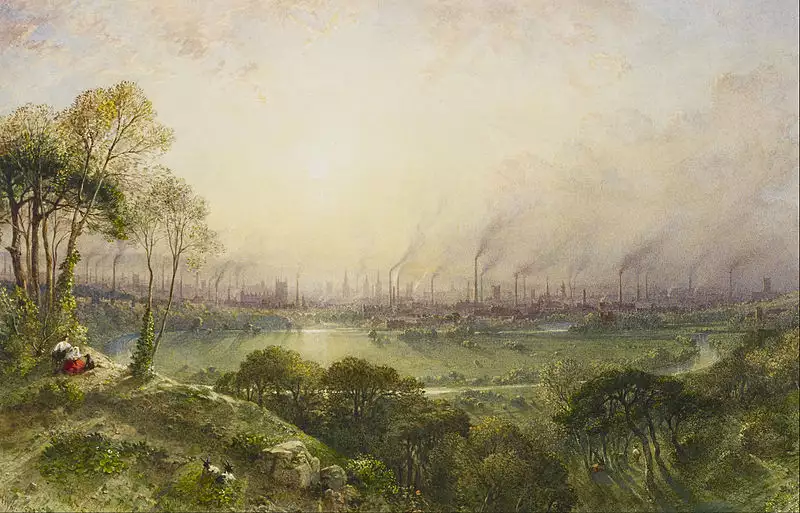chimney
A chimney is an architectural ventilation structure made of masonry, clay or metal that isolates hot toxic exhaust gases or smoke produced by a boiler, stove, furnace, incinerator or fireplace from human living areas. Chimneys are typically vertical, or as near as possible to vertical, to ensure that the gases flow smoothly, drawing air into the combustion in what is known as the stack, or chimney effect. The space inside a chimney is called the flue [烟道]. Chimneys are adjacent to large industrial refineries, fossil fuel combustion facilities or part of buildings, steam locomotives and ships.
Domestic chimneys first appeared in large dwellings in northern Europe in the 12th century. The earliest extant example of an English chimney is at the keep [城堡中的强固主楼] of Conisbrough Castle in Yorkshire, which dates from 1185 AD. However, they did not become common in houses until the 16th and 17th centuries.
Chimneys in ordinary dwellings were first built of wood and plaster or mud. Since then chimneys have traditionally been built of brick or stone, both in small and large buildings. To control downdrafts, venting caps (often called chimney pots) with a variety of designs are sometimes placed on the top of chimneys.
In the 18th and 19th centuries, the methods used to extract lead from its ore produced large amounts of toxic fumes. In the north of England, long near-horizontal chimneys were built, often more than 3 km (2 miles) long, which typically terminated in a short vertical chimney in a remote location where the fumes would cause less harm.
The combustion flue gases inside the chimneys or stacks are much hotter than the ambient outside air and therefore less dense than the ambient air. That causes the bottom of the vertical column of hot flue gas to have a lower pressure than the pressure at the bottom of a corresponding column of outside air. That higher pressure outside the chimney is the driving force that moves the required combustion air into the combustion zone and also moves the flue gas up and out of the chimney. That movement or flow of combustion air and flue gas is called "natural draught/draft", "natural ventilation", "chimney effect", or "stack effect".
Disconnected or loose chimney fittings caused by corrosion over time can pose serious dangers for residents due to leakage of carbon monoxide into the home. Thus, it is recommended - and in some countries even mandatory - that chimneys be inspected annually and cleaned on a regular basis to prevent these problems. The workers who perform this task are called chimney sweeps or steeplejacks. This work used to be done largely by child labour, and as such features in Victorian literature. In the Middle Ages in some parts of Europe, a crow-stepped gable [山墙; 三角墙] design was developed, partly to provide access to chimneys without use of ladders.
So-called chimney-sweep cancer was a particularly common condition in 18th century Europe. Traditionally, chimney sweeps hired young boys, generally orphans or children from poor families, who were small and could climb inside the chimney to brush it. Although chimney sweeping was common across Europe and North America during the 18th century, chimney-sweep cancer was predominantly found in English chimney sweeps, probably because the chimney flues were narrower and Londoners often hired young boys aged between 4 and 7 years who could fit through the ducts. Additionally, the poor hygiene conditions at the time meant that these children would bathe normally once a year and would often work naked, repeatedly exposing their skin to toxinsin the chimney soot. In England at that time there was no law regulating child labour and the first Chimney Sweepers Act was passed in 1788, stating a minimum working age of 8 years. The British Parliament, concerned about child labour exploitation in this setting, passed a law in 1834 prohibiting children younger than 10 years to work, and children younger than 14 years to be engaged in cleaning chimneys. In 1840, the law changed and the minimum age of apprenticeship for chimney sweeps was 16 years. However, as with previous legislation, these age thresholds were largely ignored because of the lack of enforcement and children under the age of ten were still hired.
六级/考研单词: chimney, ventilate, clay, isolate, toxic, exhaust, stove, furnace, fireplace, vertical, stack, adjacent, refine, fossil, locomotive, mud, vent, seldom, extract, ore, terminate, thereby, dense, correspond, draught, corrode, pose, reside, leak, carbon, mandate, inspect, regulate, ladder, orphan, predominant, probable, sanitation, bathe, norm, naked, exposition, parliament, exploit, prohibit, engage, apprentice, legislate, threshold, enforce

Smokestacks in Manchester England c. 1858 watercolor by William Wyld




 浙公网安备 33010602011771号
浙公网安备 33010602011771号